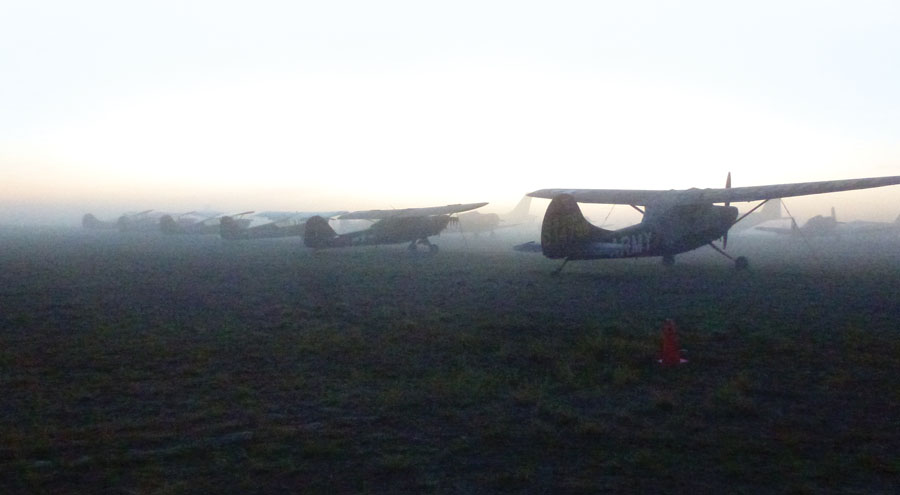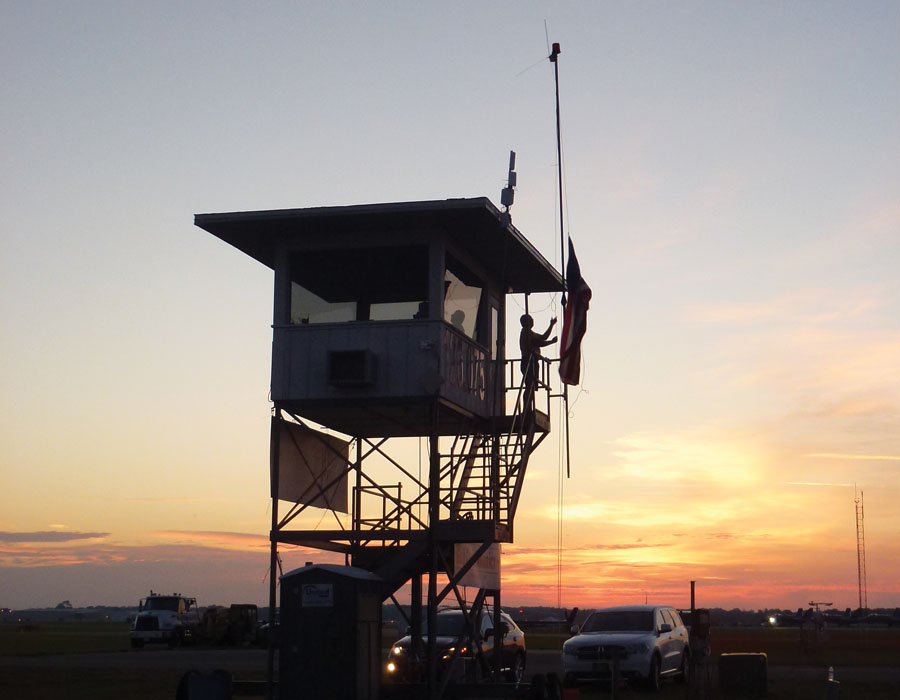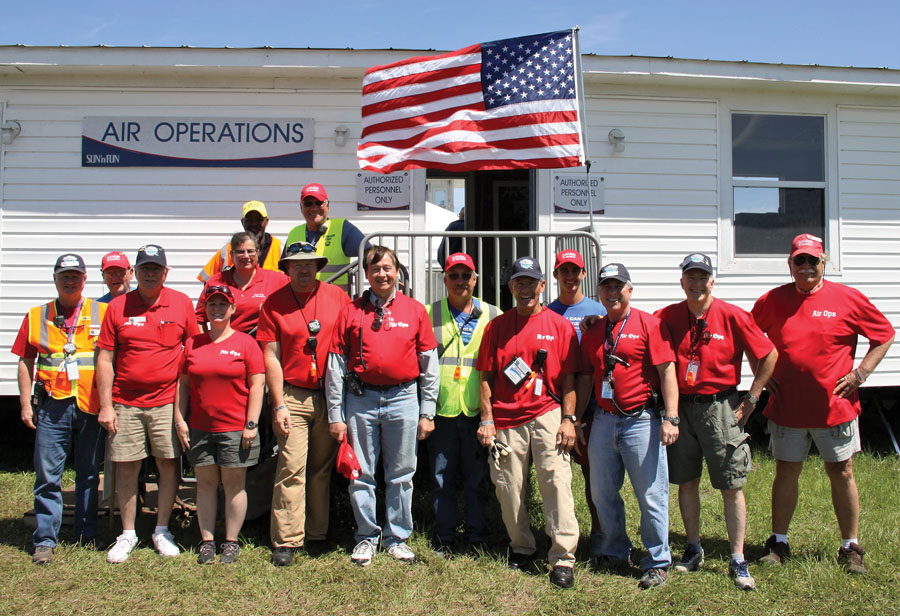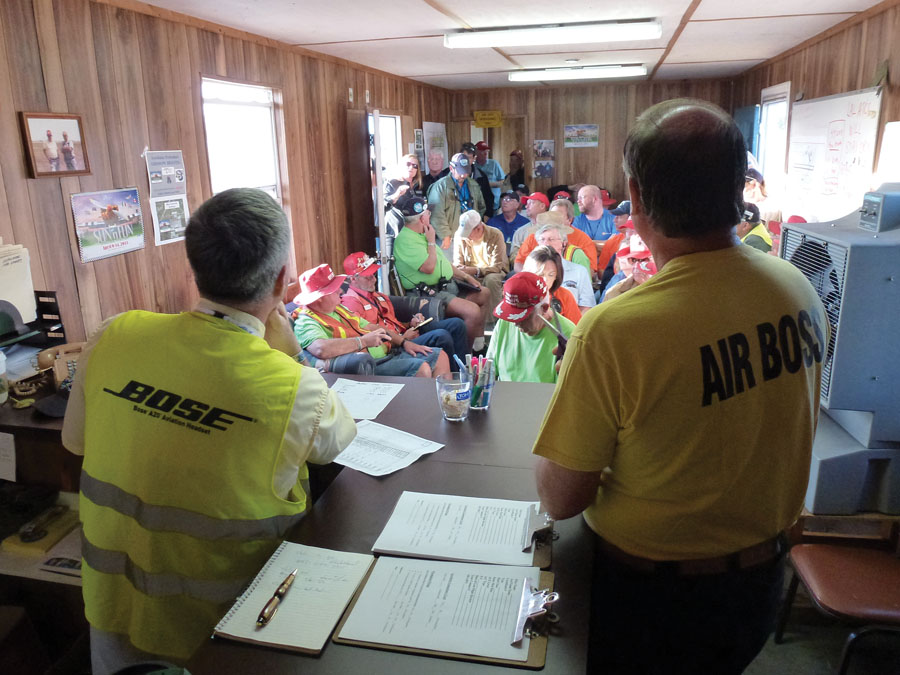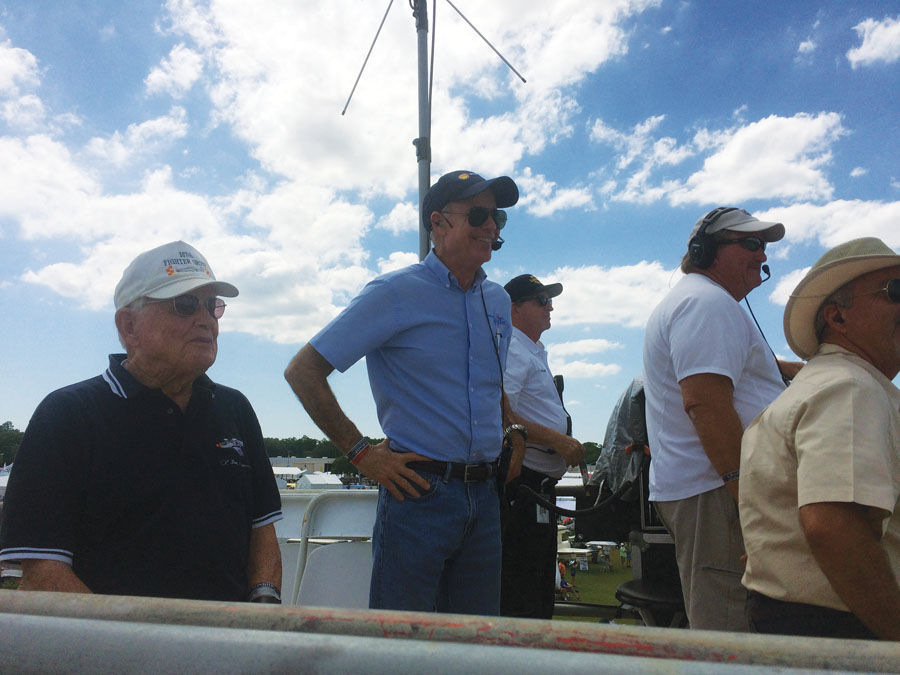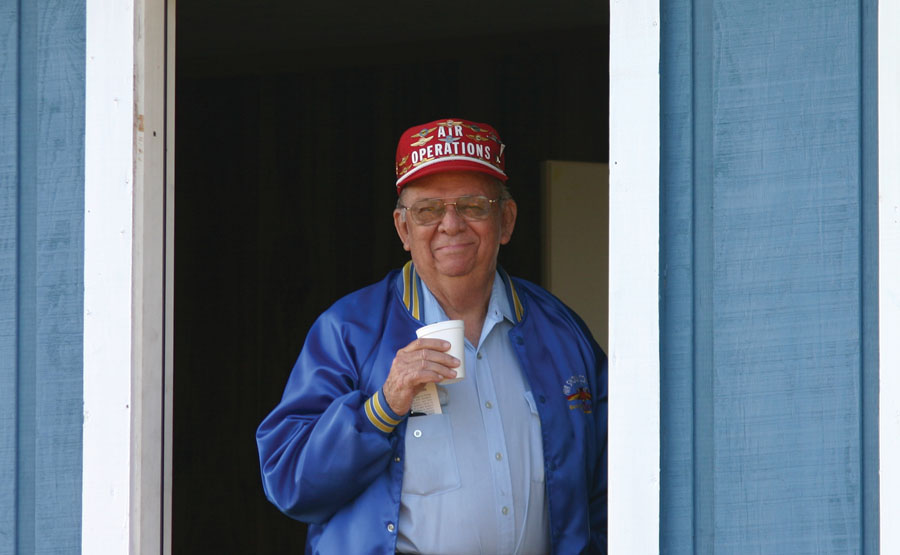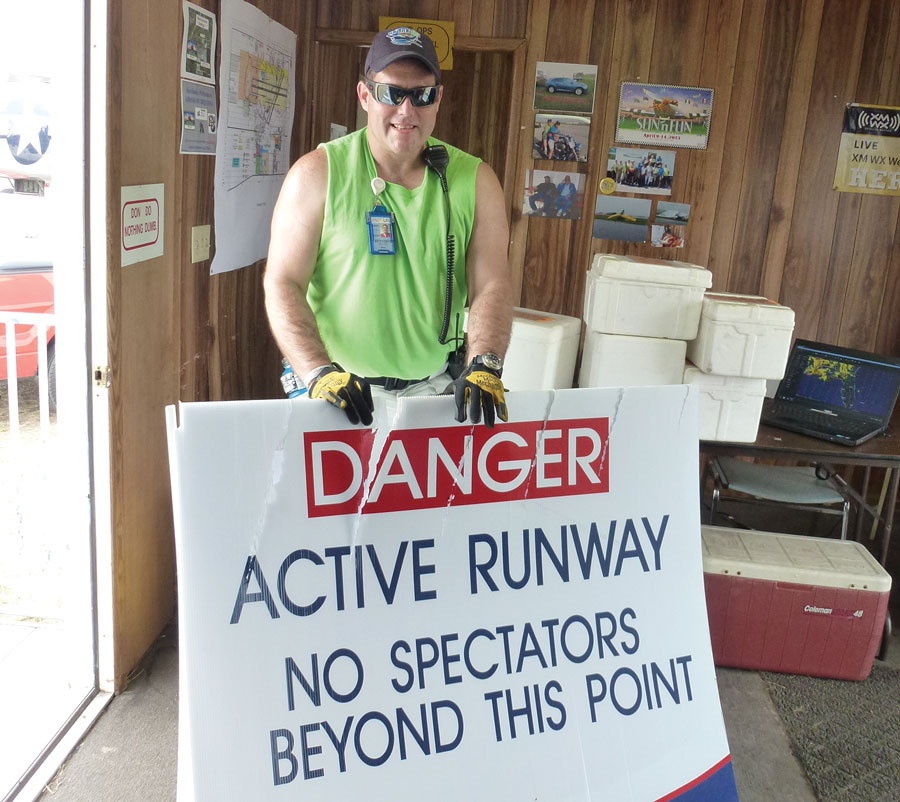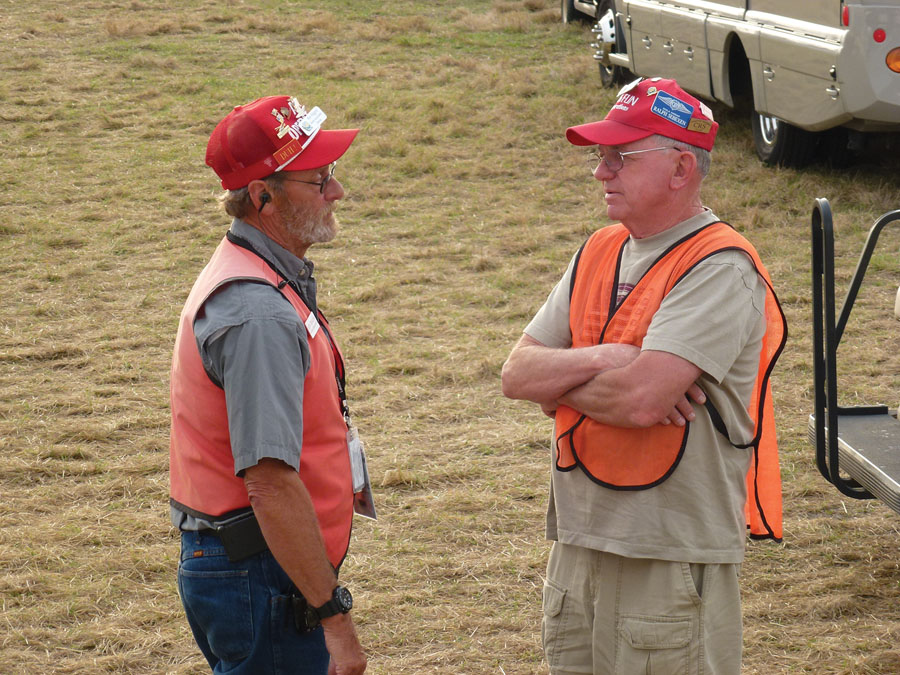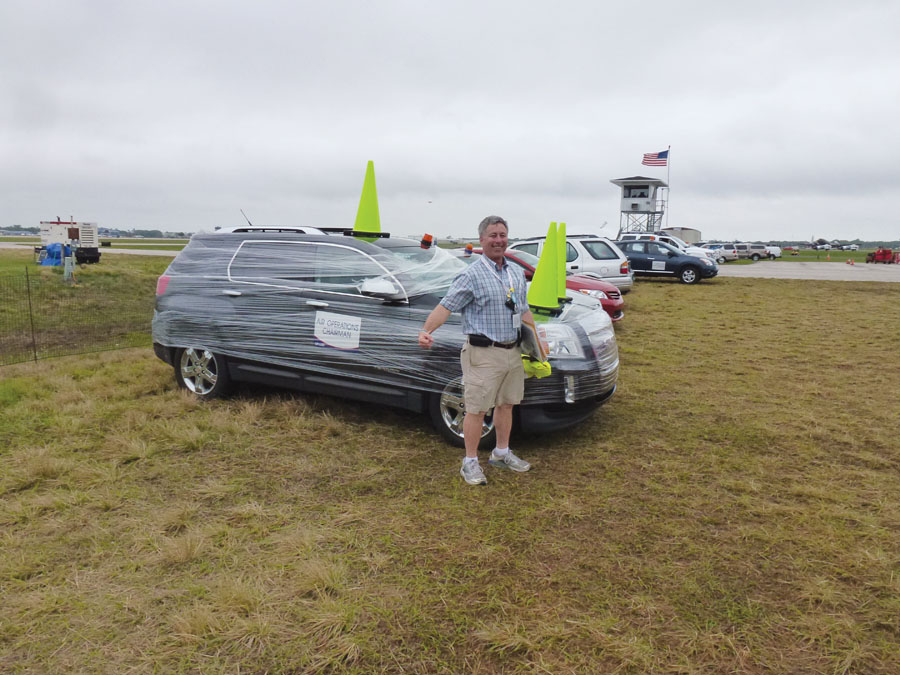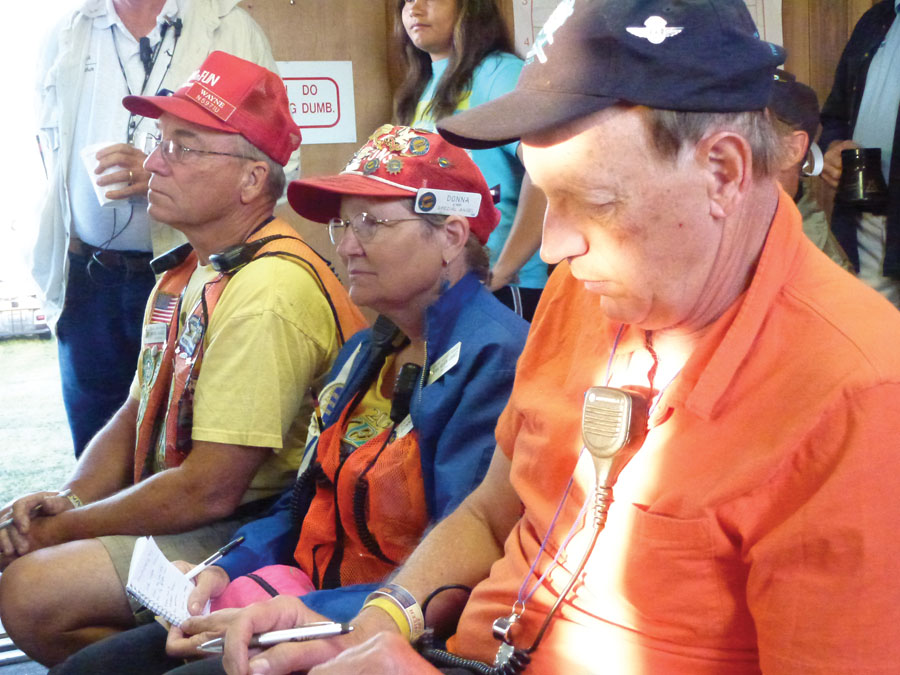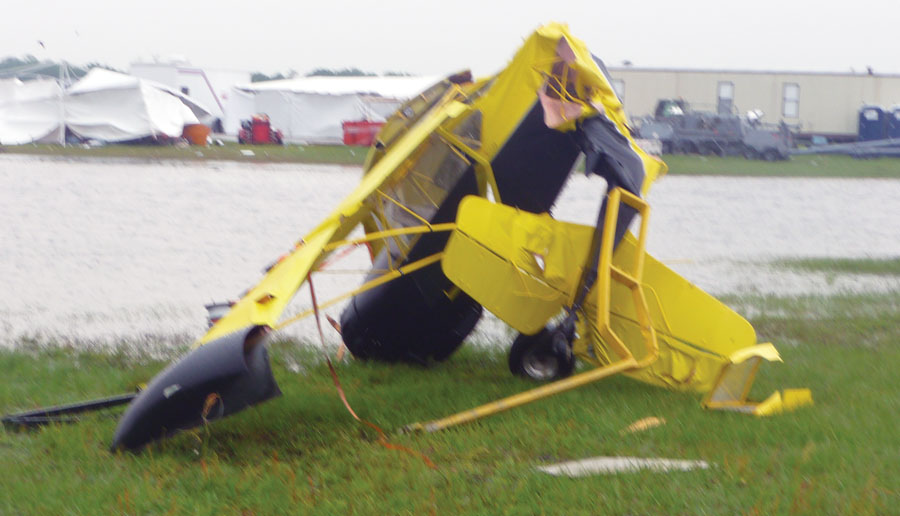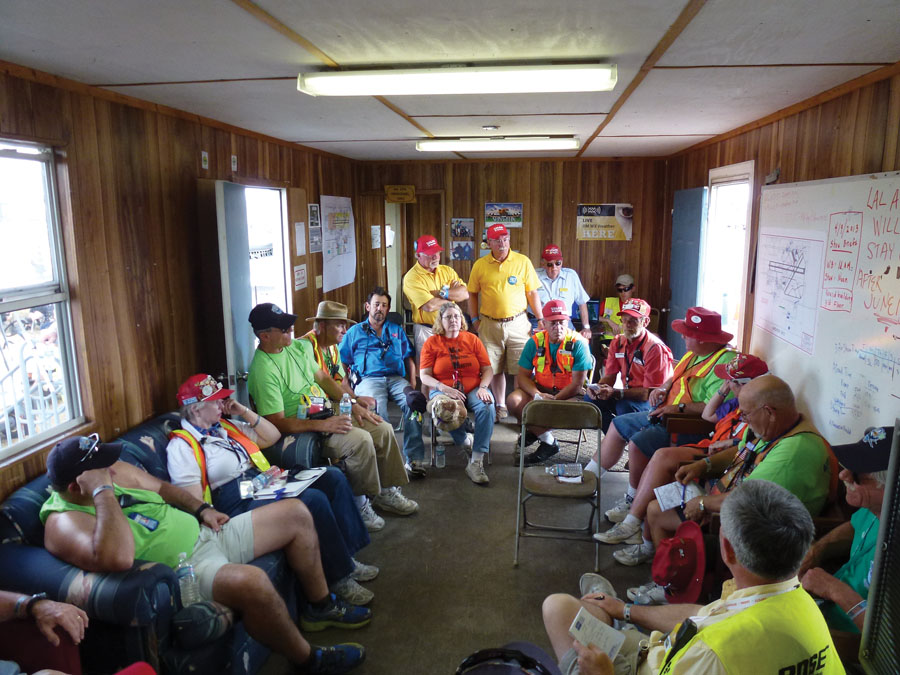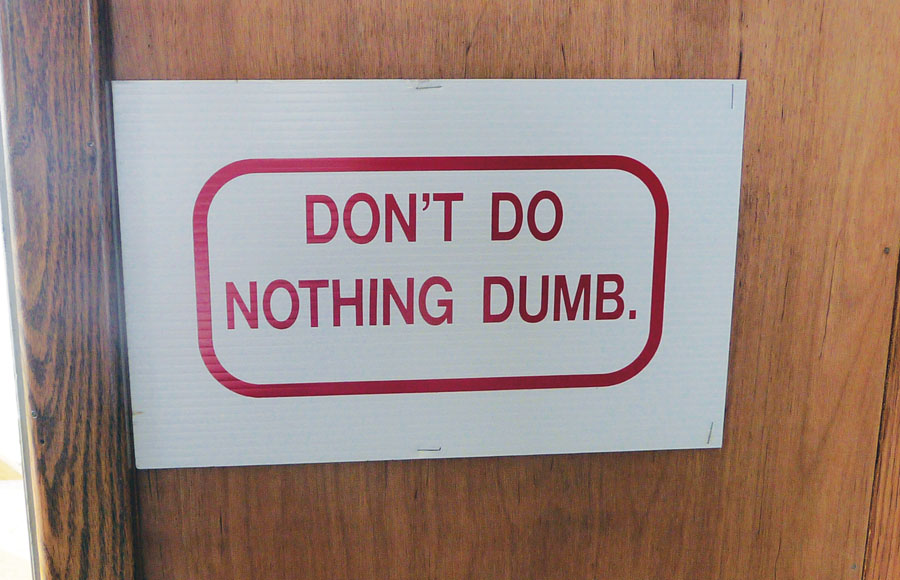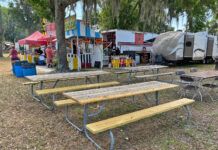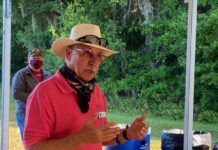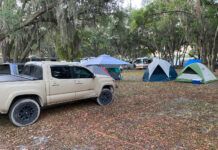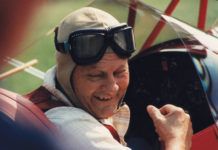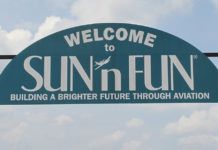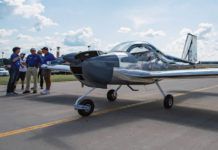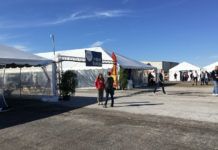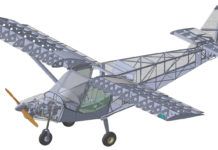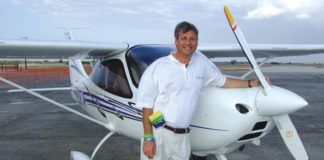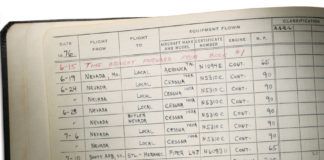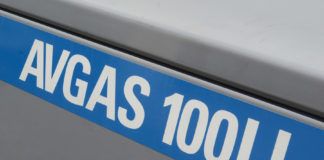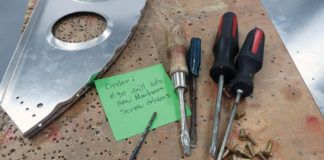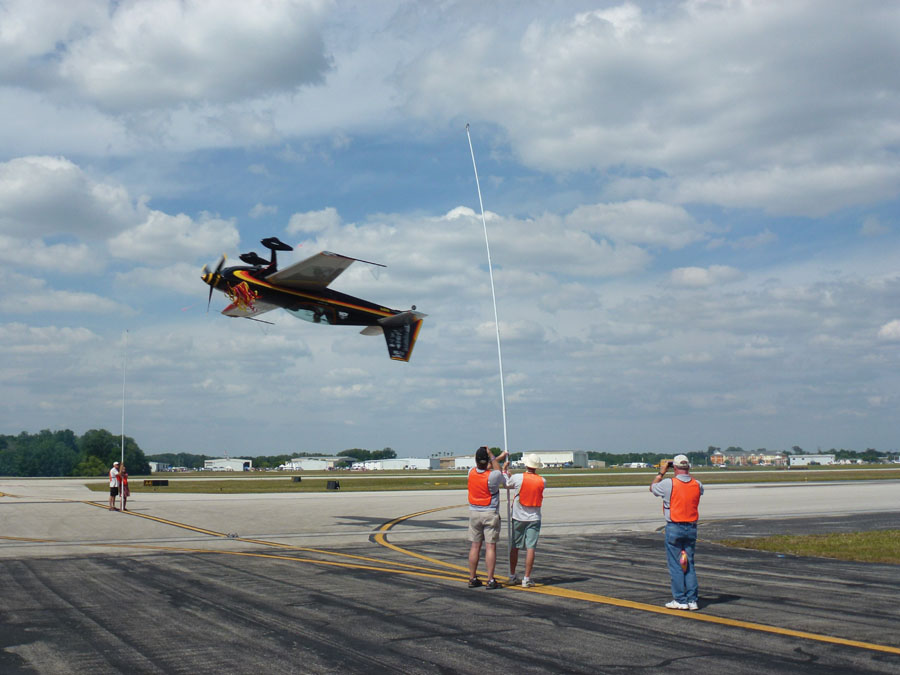
Patti Wagstaff performing at Sun ‘n Fun 2014. Pole holders are staff and helpers, sponsors and friends.
With a groan I open an eye, roll out of bed and grab for my phone, press the screen, and shut off the alarm. The clock says it’s an ungodly hour of the morning, and for a moment I struggle to remember where I am. If it’s 6 a.m. in Florida, it’s 3 a.m. back home, and before that I was somewhere overseas on a trip, and I’m still jetlagged. Doesn’t matter anyway…I volunteered for this, I tell myself, as I stumble into the shower and throw my clothes on while checking out The Weather Channel. The flying circus called Sun ‘n Fun opens today, and we’ve got a show to put on.
Thirty minutes later I’m passing through the back gate. My almost-all-access pass gets me a friendly wave, but they still check my ID as I exchange happy talk with the guard who’s been up all night. Lakeland Airport becomes a small city during Sun ‘n Fun, and I drive carefully to avoid the people already walking along the taxiways in the darkness. Sun ‘n Fun happens because of the work of over 3000 volunteers, and in the morning the taxiways can be busy with half-awake people.
The lights are on at the Air Ops shack, and despite it being 6:50 a.m., I know either Gator or MudDawg have beaten me to work. I can claim that Gator, aka Brian Geiger, a Sun ‘n Fun pioneer who has been volunteering since he was a kid, is younger than me and thus doesn’t need so much sleep, but Ron “MudDawg” Barretto is pushing 70, so I can’t claim any special dispensation for my 56 years. And even if I tried, I’d be mercilessly beaten down for it by this group. I’ve been working with them for six years now, through the sticky heat of Florida days and the heart-chilling tornadoes of 2011.
“Plan the flight, fly the plan,” as the old saying goes. At Sun ‘n Fun Air Ops that translates to plan the day, then be ready for anything thrown at you, so every morning at the crack of dawn, all the operational department heads meet to talk things out. We used to meet in the tiny Air Ops shack, cramming 30-40 people into a small trailer on the flight line that comfortably held 20, but a couple years ago we moved to a bigger venue. It allows us to be a bit more comfortable and stretch out, but I miss the intimacy of literally rubbing shoulders with others, and sometimes the closeness forced departments to confront instead of avoid problems. It’s all good though, and in the time before the meeting, people circle the coffee pot, renewing old friendships, starting new ones, and talking informally about how their section is going. It’s early in the week, and even though we’ve been talking about this year literally since before last year’s show ended, there are still hiccups and things that need to be fixed. Everyone’s used to this, and we roll with it.
Morning Briefing
Sam “Flipper” Huffstetler, Air Ops chairman, starts the meeting at 7:30 with a brief summary of the day’s activities, I give a weather brief, and we go around the horn, every department checking in with a SITREP (situation report). Some problems we’ve seen before and are easy to fix; others are harder, and we make notes. By having everyone in one place, some problems can be solved by putting heads together or talking across the room. But, others…Yeah, we have bad days, but even though the majority of the people in the room are volunteers, many of us are professionals in our fields. And, while people will fight for their turf, everyone wants the show to succeed and will work together to make it happen.
A quick half-hour later and the meeting is over; it seems like more problems get brought up and solved after the meeting than during it. “Flipper, got a sec?” someone calls. “Duck, I need you over here,” and MudDawg waves me over. After six years in Air Ops, I feel like I’m up to speed, but in my new position as Air Ops co-chair, I’ve found there is still so much I don’t know. MudDawg brings me over for a teaching moment. It’s hard to learn a new job when you only do it one week each year and the tests and lessons are given at the same time. But at the same time, dang, is it fun.
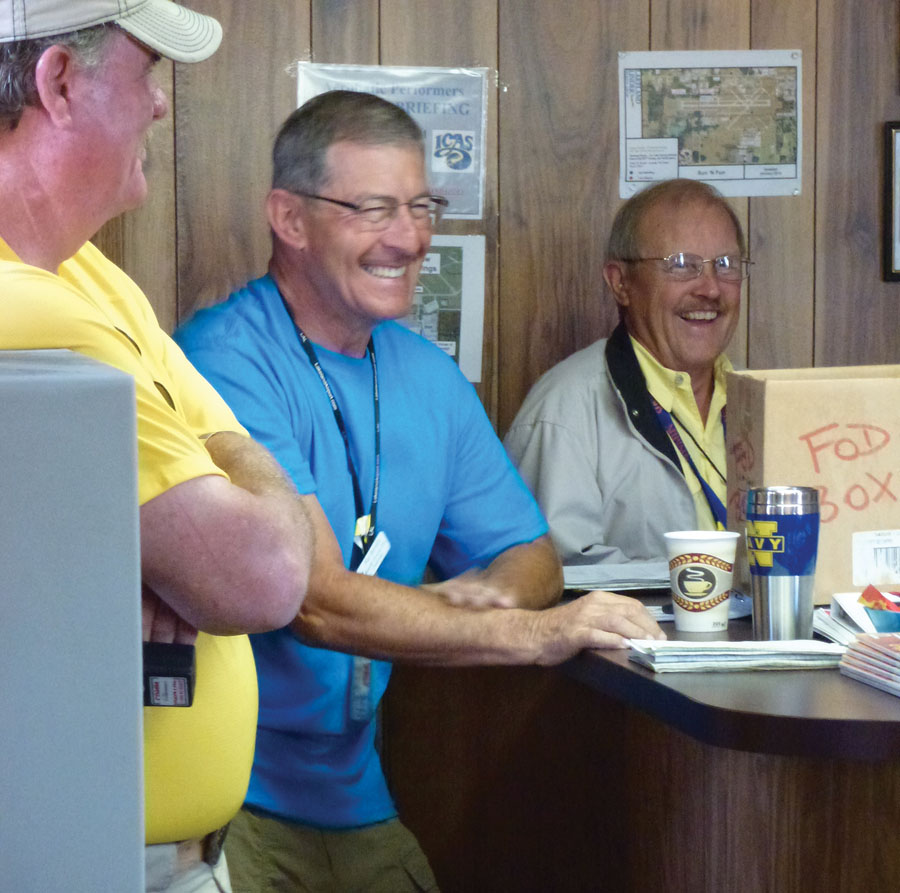
The job is serious, but you also have to enjoy your work. Air Boss Wayne Boggs, Ron Baretto, and Dick Hanusa share a laugh during a briefing.
A few minutes later the tent is almost empty, and our core group of Air and Ground Ops crew gather together. Don “NASA Don” McLendon talks about a problem in General Aircraft Camping he’ll be working, then MudDawg, Gator, and I talk about problems from the meeting and discuss strategies, responsibilities, and solutions. It’s early in the week and things are going smoothly, but we know problems will crop up, usually at the worst possible time. They always do.
I’ve got a to-do list already, so after the meeting I hit the ground running and try to quickly knock something out, grabbing a golf cart and heading over to Homebuilts. I see an RV with a distinctive Avatar-inspired paint scheme being guided by one of Ken Higgin’s escort bikers, and I start to head its way. But at that moment my radio crackles, and I’m off to a higher priority mini-crisis.
Thirty minutes later with the crisis solved, I’m running late, and I head to the Emergency Response Team briefing. It used to be that the only thing we had to worry about at an airshow was the occasional aircraft mishap, but security concerns are a fact of life now for any public event—and, let’s face it, a week-long airshow is pretty high profile. We listen intently to the brief by some alphabet agencies. Coming out of the meeting, the radio is quiet and all is well with the world as I hustle to the airshow briefing, which today is two parts: warbirds and performers.
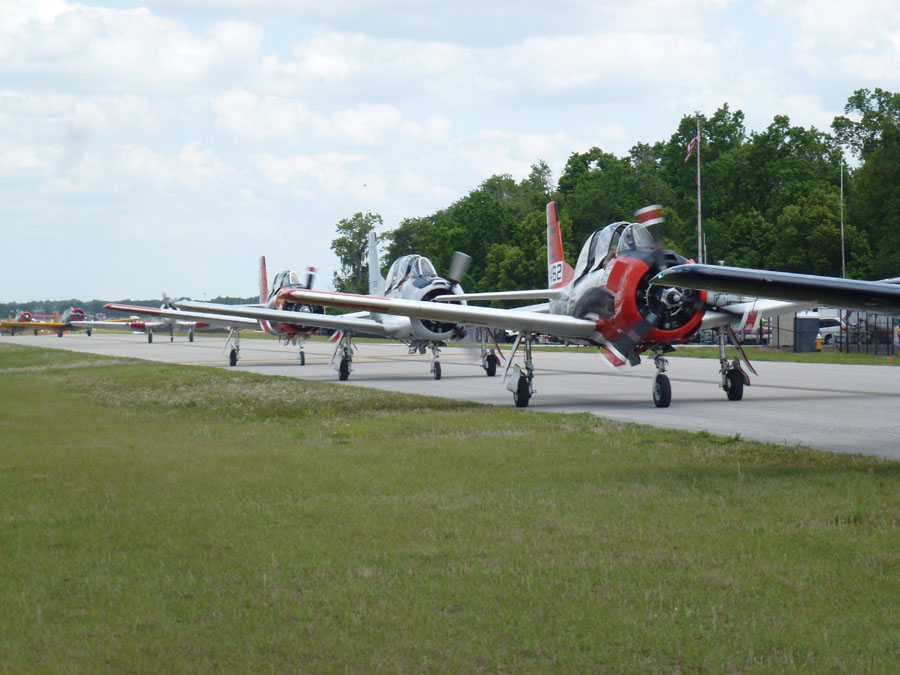
Being in Air Ops means sometimes you have to go examine the outbound airplanes. Getting this close to outbound T-28s is a treasured perk of the job.
I’d Rather Be Flying
As much fun as it is working in Air Ops, as a pilot I’ll be the first to admit I’d rather be flying the planes than being the guy with a clipboard. But I’ve (mostly) accepted that wasn’t to be, and (mostly) without envy I sit in the brief and do what I can. Let’s face it: As fun as the 787 is to fly at my day job, it’s not a P-40 or B-17. And the performers—my respect for them has only grown as I’ve gotten to know them—they’re the kind of people you’d hope they’d be. I play fly on the wall, taking notes as the air boss runs through his brief and today’s show is put together. Every so often I’m called on, and either I have the answer or I make a note to get it. On a simple thing I should know but don’t, the boss rags on me with a smile and a wink. Everyone gets their turn in the barrel.
A few performers come over with needs ranging from passes for crew, to specific aircraft needs. One of the military demo teams needs a couple things, and when they discover I’m a first officer for a major airline, they ask about getting an application in. Wait a sec, I think, you’re asking me for help? I tell them I’d be happy to carry their rsum in exchange for a ride, then give them the name of a friend in pilot recruiting. “Always need to bring good pilots onboard, even if they are single-seat fighter weenies,” I tell them, and we share a laugh before wishing each other a good show. As busy as I am, I know they’re even busier with public appearances today; the flying is a small part of what they do, and it’s appreciated.

Sun ‘n Fun doesn’t fly without the effort of over 3000 volunteers who do everything from marshaling visiting aircraft…
This year we’ve also got the Red Bull Air Racers doing a demo, and Kirby Chambliss asks if he can launch from taxiway Foxtrot across the runway. I’ve never seen Kirby fly in person, so when I tell him that will only give him about 300 feet, he smiles and says, “No problem.” I tell him I’ll check with the boss, and if it’s ok with him, we’ll make sure he has a clean lane to launch in.
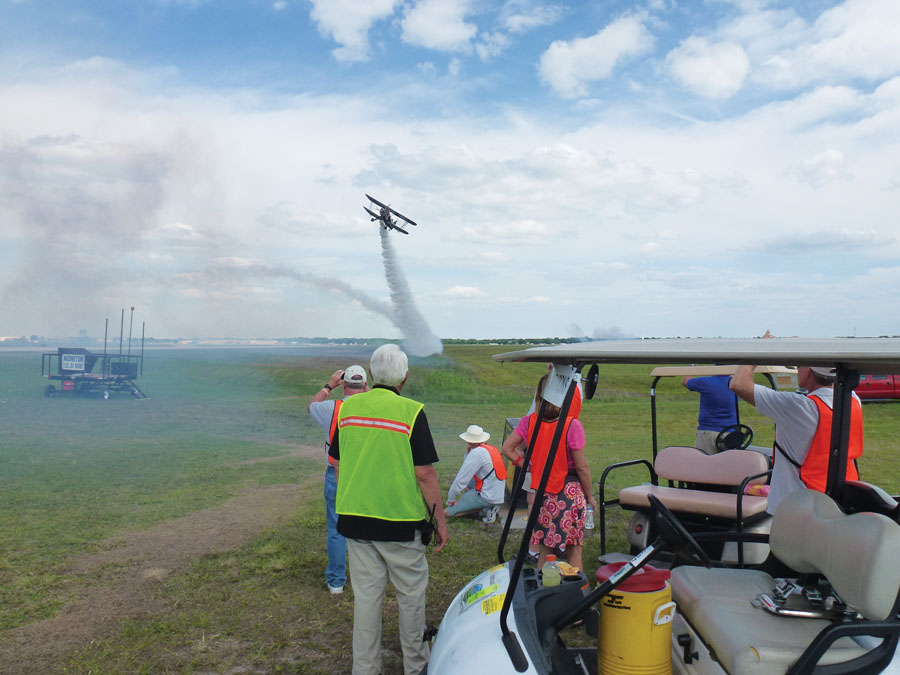
Yet another perk is getting up-close views of the performers’ routines while safety monitoring their crews.
I never thought they’d end, but the morning’s meetings are finally over, and I head back to the shack and its laid-back group of denizens to check in. One of the performers has stopped by to say hi, Flipper was on the phone in a corner scribbling notes, Gator was somewhere on a project, and MudDawg was sitting on the couch, apparently shooting the breeze with some visitors—but closer examination showed they were from another division and were working a problem. Bill Wheeler was talking with his crew of inspectors about a paperwork issue, watched over by a photo on the wall of his late father, Mac, an institution in Air Ops. Bill’s daughter, Beth (aka Tequila), was behind the counter with her 2-year-old son, who has already been given the nickname of Shotz and is, unbeknownst to him, already becoming known as Sun ‘n Fun’s youngest, and perhaps the first, 4th-generation volunteer.
We have a mini-meeting of our own, catching up on what we’ve learned from the briefings we’ve attended and adjusting our plans for the day as needed. Flipper asks if I’ve heard from our newest volunteer. I tell Flipper there’s no sign of him, he’s not returning my phone calls, and we all share a knowing look. Volunteers come to Air Ops expecting it to be free entry to the show, an 8-to-5 job, and rubbing elbows with the performers. But the reality is that we’re almost constantly moving, doing everything from helping arrange more port-a-potties at a campground, to stringing fence or standing security over the fireworks guys while the Thunderbirds do their practice airshow overhead. For every fun job, there are many, many others that have to be done, and are just as—if not more—important. As I look around the shack, I realize that, while we’re all type A people with strong work ethics, none of us are showboaters with a high need for recognition. These are the kind of people I like to be around.
Always More to Do
I jump back into my to-do list, but Flipper’s thrown a high-priority project my way. One of the Red Bull Air Race pylons is causing a conflict with a remote ATC communications cart, aka “GATOR,” that sits by the side of the runway. Once more into the breech, dear friends, I think, as I head out to the GATOR to get ATC’s side of the story; a half hour later, I’m on the FAA’s side in the argument. Later that evening, after the airshow, I meet with the Red Bull crew, and they quickly have me on their side, simply by explaining the safety issues involved. I get back to the feds, explain the situation, and they agree. They tell me they’ve got it, it’s done, don’t worry about it, they’ll make it work. The next day, they do. OK guys, thanks for making it easy and taking a big one off me.
Most of the rest of the list goes easily, but frustratingly, I run out of time and have to put some things off until tomorrow, which is bad because I know tomorrow will bring its own set of problems. Dang. A quick lunch, it’s airshow time, and I’m off to my new job.
“Thou shall go where the action is,” the saying goes, and you can’t get any closer to the action than the air boss tower. A couple years ago, I was posted in the tower as a go-between between Air Ops and the air boss during the show. It worked great, and now I’ve got an airshow junkie’s dream position: show center, above everything with nothing blocking my view, and six feet from the air boss. On the other hand, if we start to have a bad day and things are going downhill, I’ve got an air boss six feet away staring daggers at me while I’m on the radio trying to get things fixed.
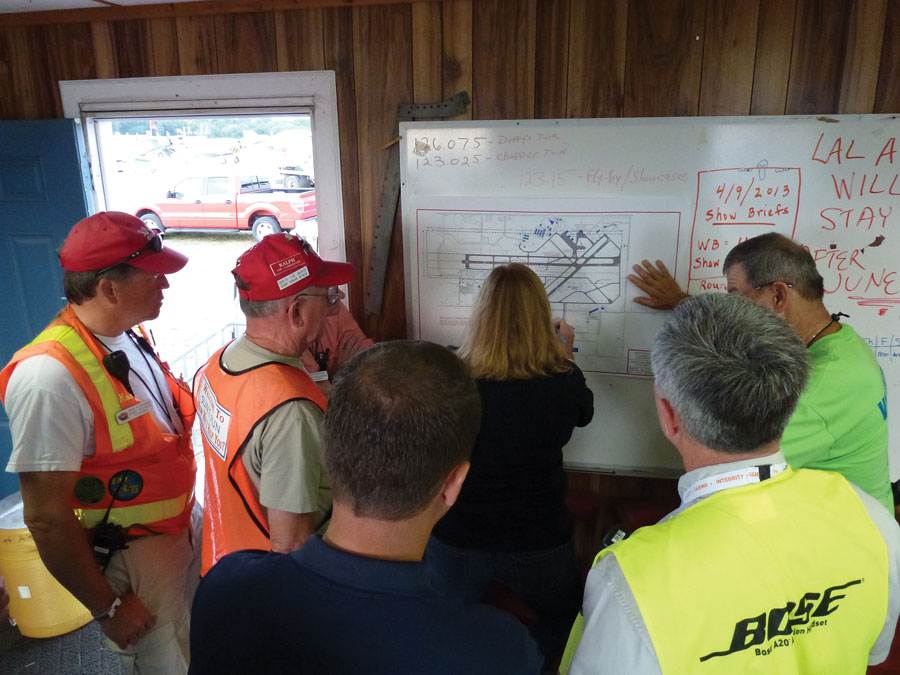
Despite all the planning, during the week we often are faced with dynamic situations and have to “call an audible” to solve a problem.
A few years ago we had a bad afternoon show. We all got together for a quick bite and tried to come up with solutions, then jumped into the night airshow. For some reason it was just a snakebit day, and while no one got hurt and no airplanes got bent, we ended the night tired, frustrated, and beat down. As I was gathering my gear in the tower around 10:30 p.m., the boss asked me to call our group together in Air Ops for a debrief.
It was a hangdog group the boss stood in front of about a half hour later. “Gentlemen,” the boss thundered, “You learn from your mistakes, and today we did one hell of a lot of learning. Let’s talk about how we can do better tomorrow, and since I’m not perfect, I’ll start with myself.” Setting the example, he came up with a few things he could have done better or mistakes he had made, and we all went around the horn, taking responsibility for what we had messed up, bucking each other up if we thought someone was being too hard on themselves, and talking about how things had gone wrong and how to keep it from happening again. Some were serious: We had a security violation, and some lost visitors dang near got onto the runway. Others were part of the learning curve: I didn’t know my frequencies and who was on what channel as well as I needed, resulting in me delaying the show when I was on the wrong channel trying to reach someone to fix a problem. It was pretty late when we broke, but the air had been cleared; and while wakeup calls weren’t too far away, we all slept good.
But today is a beautiful, sunny day and things go smoothly. We keep the field open as long as we can so late inbounds can land, but the decision is finally made to close the field. We’re as disappointed and frustrated as the inbound pilots are, but we’ve already got airplanes airborne and holding, waiting to start the show. Others are lined up ready to launch, the warbird crews are in their cockpits starting their engines, and at some point…

Aircraft wreckage after the tornadoes of 2011. There were no fatalities, but the sight of so many destroyed aircraft was heartbreaking.
It’s Showtime!
The show begins, and as always I get a little choked up as the national anthem plays; the singer is at the announcer’s stand one level below us. It’s fascinating to watch the boss run the show, dealing with performers stymied by mechanical gremlins or unexpected curveballs like when a military aircraft that was supposed to arrive in the morning suddenly calls inbound in the middle of an act. We keep a scan going for both ground and airborne intruders, and at one point I spot a couple of people who had somehow gotten past the fence line and were trying to lay low by a taxiway sign to watch the show. I call Security to go get them, and at the same time, one of our FAA liaisons poked his head up to point at them with a questioning “You on this?” look. I felt bad when Security picked them up and was told they were just trying to get some great photos. I had done the same thing many times myself when I was younger, but in our post-9/11 world, the risk of something happening is just too high to allow an unauthorized person near the runway. Sorry, guys—I know they would have been killer images.
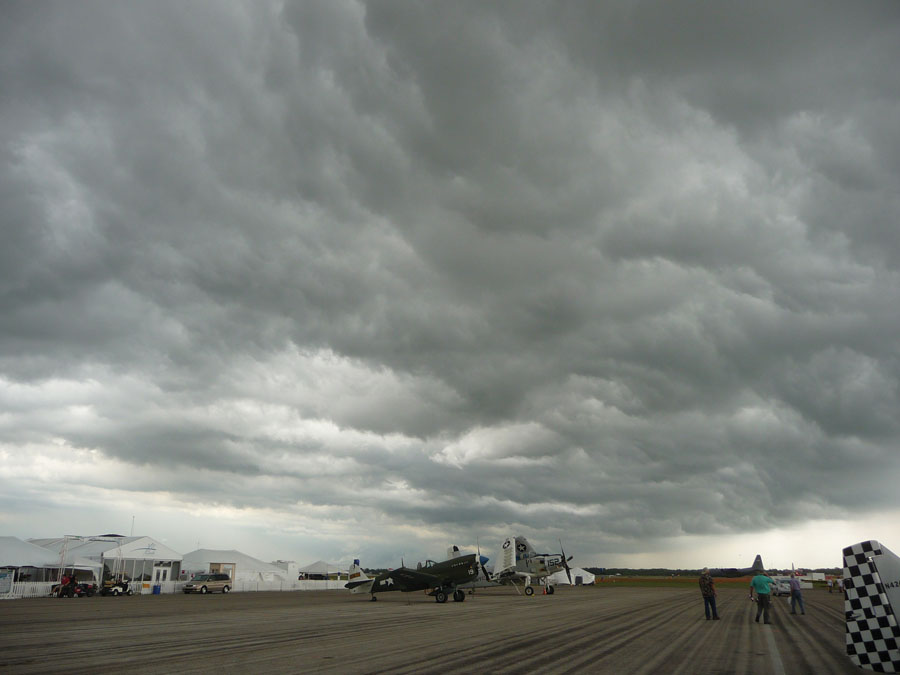
In 2011 the extreme weather on Wednesday and Thursday posed a dynamic challenge to the Air Ops crew.
I had worked it out with the boss so Kirby could take off across the runway from taxiway Foxtrot. He had said he’d be off before the runway, but he lied—he was off well before in about 100 feet! I just had to shake my head and think: I may fly airplanes, but these people are doing something else entirely. Colonel Bud Anderson is announced as a special guest in attendance, and I hustle down to escort him up to the tower. A few VIPs stop by, some small things crop up, and sometimes I’m able to anticipate and be working the problem before it’s noticed. Other times a call of “Duck! Fix this!” gets me reaching for my radio and/or cell phone. At one point I realize I’ve got a cell phone in one ear and a radio on the other while enlisting the help of some spectators below the tower to grab an Air Ops guy standing in line for ice cream and make him look up at me to give me a hand. Stress meter pegged, I’m Br’er Rabbit in the briar patch. I love my new job!
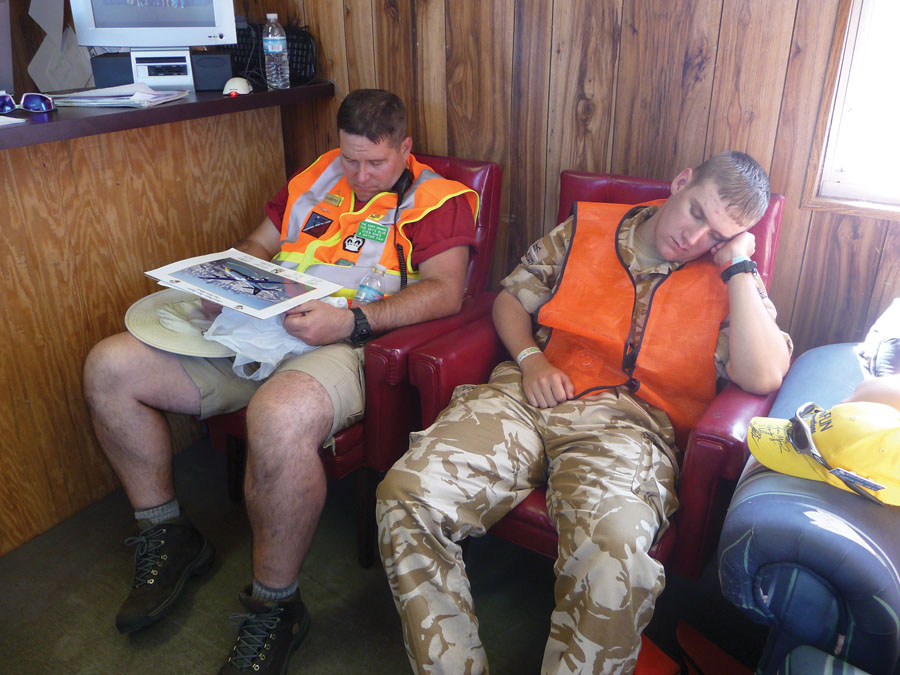
The long hours take a toll by the end of the week. Brian Geiger and a Royal Air Force cadet volunteer take a nap while the airshow goes on.
About halfway through the show, a line of weather starts moving in from Tampa, and we brace. My first year at Sun ‘n Fun was 2011, the year of the tornadoes. With my Searey build underway, I decided a research trip to Sun ‘n Fun was necessary, but it was really just an excuse to finally make it to the show. I knew Flipper from an airline-pilot internet forum and poked my head into the shack to say hello, just as their internet went down. I pulled out my brand new Android phone, brought up the Intellicast weather radar, and asked if I could be of any help. I was quickly introduced to then Air Ops Chairman Dick “Yoda” Hanusa, and as the weather deteriorated during the day, I became the unofficial Air Ops weatherman. That day we dodged the weather but knew we were going to get hit the next day, and I was asked if I could stick around to help. As we all know, the next day the show took a direct hit, with people injured and multiple aircraft destroyed. I pitched in any way I could, and after that I was officially part of the crew. Right place, right time, on a bad day.
The weather holds off, today’s show starts to come to a close, and the radio comes alive again as my cohorts in Air Ops start getting ready to reopen the field. Runway 26 is the preferred departure since it’s a short taxi from parking to the hammerhead, but safety is first, and if we have to use 08 we will, reluctantly. Across the field I can see people loading into airplanes and Kenny’s bikers and our ground marshallers getting into position. A few minutes after the last performer lands, the taxiways are full of airplanes heading home off Runway 26. This is when I start to worry, as tired pilots, who are pumped full of airshow spirit, might try to turn their Cessnas into aerobatic planes and exceed their airplanes’ capabilities. I’m guilty of it in the past, but a close call after some dumb showboating curbed my wild airplane ways a long time ago. We shake hands all around in the tower, hold a quick debrief, and I head out.
Still Not Done
Climbing down out of the tower and walking across the ramp, I reflect that my dad would have eaten this up. And if I’m ever feeling burned out during the week, I’ll take a minute and go drive around. I try to find a small family, ask if they’d like to get a special tour, load them up on my golf cart, and take them “behind the rope line,” where they can get close to the performers’ aircraft and out by the runway. It didn’t take much for me growing up to get aviation in my blood, and maybe it’s a cliche, but I hope I can reach at least one kid, show them there’s more to life than Twitter, Facebook, and the Kardashians, and get them interested in the big, wonderful world of aviation.
Even though the show’s over we’re still not done, and after talking to the Red Bull Team about their pylon, I get tasked with another problem. It’s an easy fix, but with visitors clogging the taxi- and walkways, my progress is slow as I head over to Paradise City, the ultralight flying area. A few minutes meeting with the Paradise City chairman, Gary Furdell, clears up a misunderstanding.
I’m heading back to Ops when Flipper calls me on the radio, and we meet up with other members of our crew to take a drive around the field. We talk about the day, our airlines, and general aviation flying, watch the arrivals and the sunset, and just unwind before we call it a night and start all over again tomorrow. We pick one arrival randomly and drive up to it, hop out, and as the doors open, we greet the passengers and pilot:
“Welcome to Sun ‘n Fun. How may we help you?”

